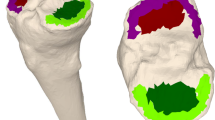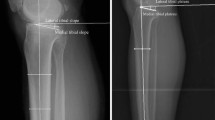Abstract
Purpose
Despite increasing interest in the functional anatomy of the menisci, little information is available regarding the relationship between the tibial slope and the menisci. It was hypothesized that the meniscus would reduce the differences in slope between the medial and lateral compartments and would mitigate the effects of age and gender on the tibial slope.
Methods
MRI sagittal images from 101 patients were used in this study. The angle between a line tangent to the medial and lateral tibial bony slope and the proximal tibial anatomical axis was measured on sagittal MRI images (bony slope). The angle between the tangent line to the highest point of the anterior and posterior horn of the meniscus and the proximal tibial anatomical axis was also determined (soft tissue slope). The measurements were carried out twice by two observers. The influence of gender and age on these parameters was analysed.
Results
Repeated measures analysis of variance showed good inter- and intra-observer reliability for both bony and soft tissue slope (ICC (0.87–0.93) and (0.91–0.97) for inter- and intra-observer reliability, respectively). In both compartments, the soft tissue significantly reduced the tibial slope towards the horizontal plane. In addition, the soft tissue slope was significantly more horizontal in the lateral compartment compared to the medial compartment (p < 0.01). These differences were not influenced by age or gender.
Conclusion
The menisci of the knee generate a more horizontal tibial slope when measured on MRI. The soft tissue slope is more horizontal in the lateral compartment of the knee compared to the medial compartment.
Level of evidence
Diagnostic, Level III.




Similar content being viewed by others
References
Bisson LJ, Gurske-DePerio J (2010) Axial and sagittal knee geometry as a risk factor for noncontact anterior cruciate ligament tear: a case-control study. Arthroscopy 26(7):901–906
Boden BP, Breit I, Sheehan FT (2009) Tibiofemoral alignment: contributing factors to noncontact anterior cruciate ligament injury. J Bone Joint Surg Am 91(10):2381–2389
Brandon ML, Haynes PT, Bonamo JR, Flynn MI, Barrett GR, Sherman MF (2006) The association between posterior-inferior tibial slope and anterior cruciate ligament insufficiency. Arthroscopy 22(8):894–899
de Boer JJ, Blankevoort L, Kingma I, Vorster W (2009) In vitro study of inter-individual variation in posterior slope in the knee joint. Clin Biomech (Bristol, Avon) 24(6):488–492
Dejour H, Bonnin M (1994) Tibial translation after anterior cruciate ligament rupture. Two radiological tests compared. J Bone Joint Surg Br 76(5):745–749
Feucht MJ, Mauro CS, Brucker PU, Imhoff AB, Hinterwimmer S (2012) The role of the tibial slope in sustaining and treating anterior cruciate ligament injuries. Knee Surg Sports Traumatol Arthrosc. doi:10.1007/s00167-012-1941-6
Galano GJ, Suero EM, Citak M, Wickiewicz T, Pearle AD (2011) Relationship of native tibial plateau anatomy with stability testing in the anterior cruciate ligament-deficient knee. Knee Surg Sports Traumatol Arthrosc. doi:10.1007/s00167-011-1854-9
Giffin JR, Vogrin TM, Zantop T, Woo SL, Harner CD (2004) Effects of increasing tibial slope on the biomechanics of the knee. Am J Sports Med 32(2):376–382
Griffin LY, Albohm MJ, Arendt EA, Bahr R, Beynnon BD, Demaio M, Dick RW, Engebretsen L, Garrett WE Jr, Hannafin JA, Hewett TE, Huston LJ, Ireland ML, Johnson RJ, Lephart S, Mandelbaum BR, Mann BJ, Marks PH, Marshall SW, Myklebust G, Noyes FR, Powers C, Shields C Jr, Shultz SJ, Silvers H, Slauterbeck J, Taylor DC, Teitz CC, Wojtys EM, Yu B (2006) Understanding and preventing noncontact anterior cruciate ligament injuries: a review of the Hunt Valley II meeting, January 2005. Am J Sports Med 34(9):1512–1532
Hashemi J, Chandrashekar N, Gill B, Beynnon BD, Slauterbeck JR, Schutt RC Jr, Mansouri H, Dabezies E (2008) The geometry of the tibial plateau and its influence on the biomechanics of the tibiofemoral joint. J Bone Joint Surg Am 90(12):2724–2734
Hashemi J, Chandrashekar N, Mansouri H, Gill B, Slauterbeck JR, Schutt RC Jr, Dabezies E, Beynnon BD (2010) Shallow medial tibial plateau and steep medial and lateral tibial slopes: new risk factors for anterior cruciate ligament injuries. Am J Sports Med 38(1):54–62
Hohmann E, Bryant A, Reaburn P, Tetsworth K (2010) Does posterior tibial slope influence knee functionality in the anterior cruciate ligament-deficient and anterior cruciate ligament-reconstructed knee? Arthroscopy 26(11):1496–1502
Hopkins WG (2000) Measures of reliability in sports medicine and science. Sports Med 30(1):1–15
Hudek R, Fuchs B, Regenfelder F, Koch PP (2011) Is noncontact ACL injury associated with the posterior tibial and meniscal slope? Clin Orthop Relat Res 469:2377–2384
Hudek R, Schmutz S, Regenfelder F, Fuchs B, Koch PP (2009) Novel measurement technique of the tibial slope on conventional MRI. Clin Orthop Relat Res 467:2066–2072
Jenny JY, Rapp E, Kehr P (1997) Proximal tibial meniscal slope: a comparison with the bone slope. Rev Chir Orthop Reparatrice Appar Mot 84(5):435–438
Jung KA, Lee SC, Hwang SH, Yang KH, Kim DH, Sohn JH, Song SJ, Hunter DJ (2010) High frequency of meniscal hypertrophy in persons with advanced varus knee osteoarthritis. Rheumatol Int 30(10):1325–1333
Kostogiannis I, Sward P, Neuman P, Friden T, Roos H (2011) The influence of posterior-inferior tibial slope in ACL injury. Knee Surg Sports Traumatol Arthrosc 19(4):592–597
Lee YS, Kim JG, Lim HC, Park JH, Park JW (2009) The relationship between tibial slope and meniscal insertion. Knee Surg Sports Traumatol Arthrosc 17(12):1416–1420
Levy IM, Torzilli PA, Gould JD, Warren RF (1989) The effect of lateral meniscectomy on motion of the knee. J Bone Joint Surg Am 71(3):401–406
Levy IM, Torzilli PA, Warren RF (1982) The effect of medial meniscectomy on anterior-posterior motion of the knee. J Bone Joint Surg Am 64(6):883–888
Matsuda S, Miura H, Nagamine R, Urabe K, Ikenoue T, Okazaki K, Iwamoto Y (1999) Posterior tibial slope in the normal and varus knee. Am J Knee Surg 12(3):165–168
McLean SG, Lucey SM, Rohrer S, Brandon C (2010) Knee joint anatomy predicts high-risk in vivo dynamic landing knee biomechanics (Bristol, Avon). Clin Biomech 25(8):781–788
McLean SG, Oh YK, Palmer ML, Lucey SM, Lucarelli DG, Ashton-Miller JA, Wojtys EM (2011) The relationship between anterior tibial acceleration, tibial slope, and ACL strain during a simulated jump landing task. J Bone Joint Surg Am 93(14):1310–1317
Meister K, Talley MC, Horodyski MB, Indelicato PA, Hartzel JS, Batts J (1998) Caudal slope of the tibia and its relationship to noncontact injuries to the ACL. Am J Knee Surg 11(4):217–219
Ng VY, Declaire JH, Berend KR, Gulick BC, Lombardi AV Jr (2011) Improved accuracy of alignment with patient-specific positioning guides compared with manual instrumentation in TKA. Clin Orthop Relat Res 470:99–107
Pauli C, Grogan SP, Patil S, Otsuki S, Hasegawa A, Koziol J, Lotz MK, D’Lima DD (2011) Macroscopic and histopathologic analysis of human knee menisci in aging and osteoarthritis. Osteoarthr Cartil 19(9):1132–1141
Senter C, Hame SL (2006) Biomechanical analysis of tibial torque and knee flexion angle: implications for understanding knee injury. Sports Med 36(8):635–641
Stijak L, Herzog RF, Schai P (2008) Is there an influence of the tibial slope of the lateral condyle on the ACL lesion? A case-control study. Knee Surg Sports Traumatol Arthrosc 16(2):112–117
Terauchi M, Hatayama K, Yanagisawa S, Saito K, Takagishi K (2011) Sagittal alignment of the knee and its relationship to noncontact anterior cruciate ligament injuries. Am J Sports Med 39(5):1090–1094
Todd MS, Lalliss S, Garcia E, DeBerardino TM, Cameron KL (2010) The relationship between posterior tibial slope and anterior cruciate ligament injuries. Am J Sports Med 38(1):63–67
Vyas S, van Eck CF, Vyas N, Fu FH, Otsuka NY (2011) Increased medial tibial slope in teenage pediatric population with open physes and anterior cruciate ligament injuries. Knee Surg Sports Traumatol Arthrosc 19(3):372–377
Whiteside LA, Amador DD (1988) The effect of posterior tibial slope on knee stability after Ortholoc total knee arthroplasty. J Arthroplasty 3(Suppl):S51–S57
Yoo JH, Chang CB, Shin KS, Seong SC, Kim TK (2008) Anatomical references to assess the posterior tibial slope in total knee arthroplasty: a comparison of 5 anatomical axes. J Arthroplasty 23(4):586–592
Acknowledgments
The authors would like to thank Dr. Sandeep Biswal and Dr. Aled Williams for their help during acquisition of the data.
Author information
Authors and Affiliations
Corresponding author
Rights and permissions
About this article
Cite this article
Lustig, S., Scholes, C.J., Leo, S.P.M. et al. Influence of soft tissues on the proximal bony tibial slope measured with two-dimensional MRI. Knee Surg Sports Traumatol Arthrosc 21, 372–379 (2013). https://doi.org/10.1007/s00167-012-1990-x
Received:
Accepted:
Published:
Issue Date:
DOI: https://doi.org/10.1007/s00167-012-1990-x




